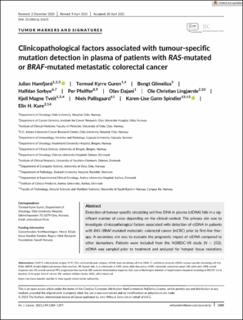| dc.contributor.author | Hamfjord, Julian | |
| dc.contributor.author | Guren, Tormod Kyrre | |
| dc.contributor.author | Glimelius, Bengt | |
| dc.contributor.author | Sorbye, Halfdan | |
| dc.contributor.author | Pfeiffer, Per | |
| dc.contributor.author | Dajani, Olav | |
| dc.contributor.author | Lingjærde, Ole Christian | |
| dc.contributor.author | Tveit, Magne Kjell | |
| dc.contributor.author | Pallisgaard, Niels | |
| dc.contributor.author | Spindler, Karen-Lise Garm | |
| dc.contributor.author | Kure, Elin Wenche Hegland | |
| dc.date.accessioned | 2022-02-14T14:17:31Z | |
| dc.date.available | 2022-02-14T14:17:31Z | |
| dc.date.created | 2022-01-24T14:48:36Z | |
| dc.date.issued | 2021 | |
| dc.identifier.citation | Hamfjord, J., Guren, T. K., Glimelius, B., Sorbye, H., Pfeiffer, P., Dajani, O., Lingjærde, O. C., Tveit, K. M., Pallisgaard, N., Spindler, K.-L. G. & Kure, E. H. (2021). Clinicopathological factors associated with tumour-specific mutation detection in plasma of patients with RAS-mutated or BRAF-mutated metastatic colorectal cancer. International Journal of Cancer, 149(6), 1385-1397. | en_US |
| dc.identifier.issn | 0020-7136 | |
| dc.identifier.uri | https://hdl.handle.net/11250/2978884 | |
| dc.description.abstract | Detection of tumour-specific circulating cell-free DNA in plasma (ctDNA) fails in a significant number of cases depending on the clinical context. The primary aim was to investigate clinicopathological factors associated with detection of ctDNA in patients with RAS-/BRAF-mutated metastatic colorectal cancer (mCRC) prior to first-line therapy. A secondary aim was to evaluate the prognostic impact of ctDNA compared to other biomarkers. Patients were included from the NORDIC-VII study (N = 253). ctDNA was sampled prior to treatment and analysed for hotspot tissue mutations (KRAS, NRAS, and BRAF) using droplet digital PCR. Multivariable regression models were constructed to predict the probability of mutation detection and survival. Increasing radiological size of target lesions by increments of 1 cm (odds ratio [OR] = 1.18; 95% confidence interval [CI] 1.09-1.27; P < .001), intact primary tumour (OR = 3.17; 95% CI 1.22-8.22; P = .018) and more than one metastatic site (OR = 3.08; 95% CI 1.32-7.19; P = .009) were associated with mutation detection in plasma. Metastatic involvement of the lung was associated with non-detection (OR = 0.26; 95% CI 0.12-0.58; P = .001). Preanalytical and analytical factors modulated detection. High allele frequencies of ctDNA indicated poor prognosis independently of CEA and CA19-9 (hazard ratio [HR] = 2.38; 95% CI 1.74-3.26; P < .001; N = 206). Clinicopathological characteristics should be carefully considered when evaluating ctDNA results from mCRC patients, especially when confronted with a plasma negative result. ctDNA may prove to be a clinically useful marker in the evaluation of mCRC treatment. | en_US |
| dc.language.iso | eng | en_US |
| dc.rights | Attribution-NonCommercial-NoDerivatives 4.0 Internasjonal | * |
| dc.rights.uri | http://creativecommons.org/licenses/by-nc-nd/4.0/deed.no | * |
| dc.title | Clinicopathological factors associated with tumour-specific mutation detection in plasma of patients with RAS-mutated or BRAF-mutated metastatic colorectal cancer | en_US |
| dc.type | Peer reviewed | en_US |
| dc.type | Journal article | en_US |
| dc.description.version | publishedVersion | en_US |
| dc.rights.holder | © 2021 The Authors. | en_US |
| dc.source.pagenumber | 1385-1397 | en_US |
| dc.source.volume | 149 | en_US |
| dc.source.journal | International Journal of Cancer | en_US |
| dc.source.issue | 6 | en_US |
| dc.identifier.doi | 10.1002/ijc.33672 | |
| dc.identifier.cristin | 1988722 | |
| cristin.ispublished | true | |
| cristin.fulltext | original | |
| cristin.qualitycode | 2 | |

